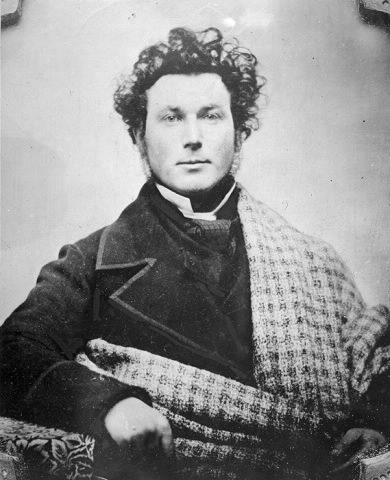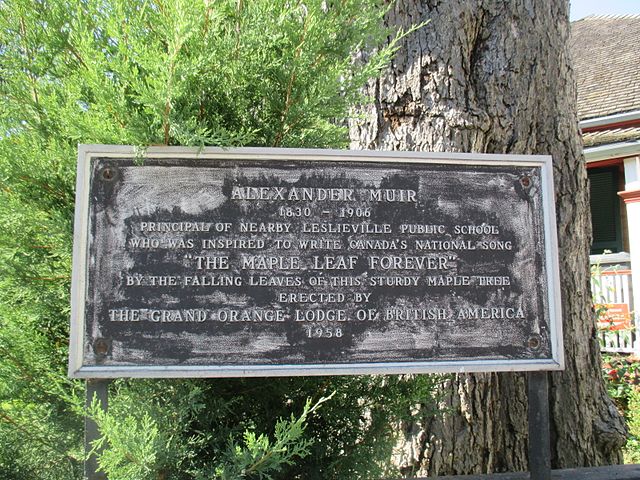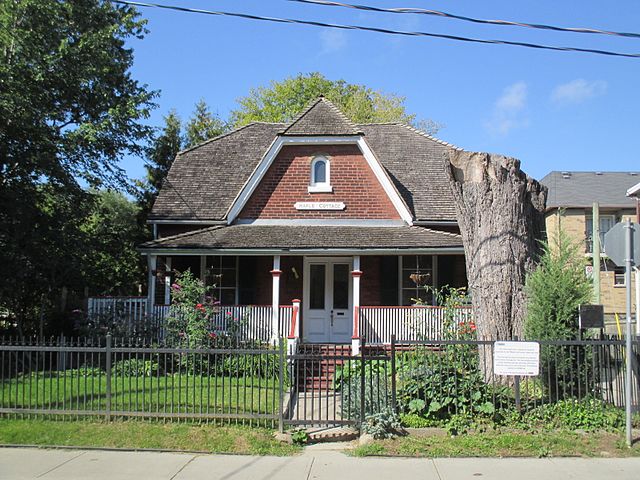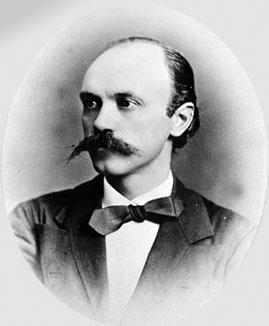
Background
Alexander Muir was principal of the public school in Leslieville, an area of Toronto named for his friend, horticulturalist and postmaster George Leslie. Muir was interested in submitting a poem to the patriotic poetry contest of the Caledonian Society of Montréal, but the deadline was looming and he had yet to produce anything. According to accounts by Muir’s widow and George Leslie, Muir and Leslie were walking near Leslie’s Gardens when a fallen maple leaf became lodged on Leslie's coat sleeve, despite his efforts to brush it off. "There Muir, There's your text!” Leslie is said to have exclaimed. “The maple leaf is the emblem of Canada! Build your poem on that.” Muir wrote the poem and dispatched it to Montréal a few hours later (it won second prize). Muir's search for a suitable tune in local music stores proved futile, so he wrote his own.
Context
The song essentially celebrates British military victories in Canada and the manner in which they ostensibly united the country. The first verse refers to Wolfe’s conquest of Québec at the Battle of the Plains of Abraham during the Seven Years’ War. It also includes a gesture of allegiance and loyalty to Canada’s colonial forefathers by noting the unification of the floral emblems of Scotland (thistle), Ireland (shamrock) and England (rose). The song’s second verse refers to the hard-fought British victories during the War of 1812 at the Battle of Queenston Heights and the Battle of Lundy’s Lane.
First Edition and Performance
The original edition (reprinted in The Canadian Musical Heritage/ Le Patrimoine musical canadien vol. 3), supposedly consisted of 1,000 copies and bears no date and no copyright notice. It was issued probably early in 1868, "published for the author," and printed at the Guardian Office in Toronto, the publishing outlet for the Methodist Book Room. The story that Muir paid $30 to have the song printed and took in less than half that amount is plausible. On the other hand, it is hard to believe Leslie's claim that Muir did not receive "one cent" of royalties from music publisher Nordheimer, who published the first copyrighted edition in 1871. This edition advertised on its cover that the song was "sung with great applause by J.F. Hardy, esq., in his popular entertainments," thus contradicting another story which purports that the first public performance of "The Maple Leaf Forever" took place on 24 July 1874 when Muir directed school children during the laying of the foundation stone of a church in Newmarket, north of Toronto, in the presence of the Earl of Dufferin.
Revisions
The lyrics of the song were revised by Muir several times. On a copy of the original edition, preserved at the National Library of Canada (now Library and Archives Canada), Muir's own hand has corrected the first line of the chorus "The Maple Leaf, the Maple Leaf, the Maple Leaf for ever!" to read "The Maple Leaf, our emblem dear, the Maple Leaf for ever!"
There were other small revisions, and a major one in 1894. On 8 September of that year, the Toronto newspaper The Empire quoted a letter written by Muir in which he complained that incorrect versions of the words of his song had been circulated and went on to give the correct version. This appears to have been a deliberate mystification, for not only do all known pre-1894 versions conform to the original text and its minor adjustments, but the "correct" version really was a new one, having five stanzas instead of four. In fact, the two versions share only two stanzas. The 1894 version, with the awkward opening "In days of yore, the hero Wolfe Britain's glory did maintain," appeared in several publications at the turn of the century, but the original version remained the popular one: "In days of yore, from Britain's shore, Wolfe the dauntless hero came."
To make good the oversight of the French heritage in Canada, some later editions changed "The thistle, shamrock, rose entwine" to read "The lily, thistle, shamrock, rose" but no French translation of the song has been located. There is however a poem written by Octave Crémazie before 1862 — "Salut, ô ma belle patrie!" — paired with Muir's melody in the songbook Choix de chansons.
Arrangements
The music is almost always printed in the key of B flat. The tune, which owes something to "My Love is Like a Red, Red Rose," is cheerful, but its organization is confusing. Verse and chorus begin with the same eight notes, except that the fourth and fifth are at different pitches of the same chord. The sequence G-B flat-F occurs five times, but in four different melodic contexts. It is no wonder that Alexander Cringan, in his school edition, marked five notes with asterisks, warning the teacher that these "are sometimes sung incorrectly."
In 1964, music publisher Thompson published "'Our Home, Our Land, Our Canada," which contained Muir's music with lyrics by Victor Cowley, who had won the Canadian Authors Association Maple Leaf song contest.
Original Lyrics
In Days of yore,
From Britain's shore
Wolfe the dauntless hero came
And planted firm Britannia's flag
On Canada's fair domain.
Here may it wave,
Our boast, our pride
And joined in love together,
The thistle, shamrock, rose entwined,
The Maple Leaf Forever.
[CHORUS]
The Maple Leaf
Our Emblem Dear,
The Maple Leaf Forever.
God save our Queen and heaven bless,
The Maple Leaf Forever.
At Queenston Heights and Lundy's Lane
Our brave fathers side by side
For freedom's home and loved ones dear,
Firmly stood and nobly died.
And so their rights which they maintained,
We swear to yield them never.
Our watchword ever more shall be
The Maple Leaf Forever
[CHORUS]
Our fair Dominion now extends
From Cape Race to Nootka Sound
May peace forever be our lot
And plenty a store abound
And may those ties of love be ours
Which discord cannot sever
And flourish green for freedom's home
The Maple Leaf Forever
[CHORUS]
1997 Revised Version
In 1997, CBC Radio held a contest to come up with more inclusive lyrics for the song. The winning submission — by Vladimir Radian, a mathematician, poet and songwriter who had immigrated to Canada from Romania — received its public debut in a performance by the Toronto Symphony Orchestra on 27 June 1997.
A slightly revised version of these lyrics, with the fourth and fifth verses omitted, was sung by Anne Murray before the final game played by the Toronto Maple Leafs at Maple Leaf Gardens. Another revised version of Radian’s lyrics, which omitted some verses, inverted their order, and added part of the melody from CBC TV’s Hockey Night in Canada theme song, was performed by Michael Bublé at the closing ceremonies of the 2010 Winter Olympic Games in Vancouver. It was also included on the compilation album Sounds of Vancouver 2010: Closing Ceremony Commemorative Album (2010).
Vladimir Radian’s Lyrics
O, land of blue unending skies,
Mountains strong and sparkling snow,
A scent of freedom in the wind,
O'er the emerald fields below.
To thee we brought our hopes, our dreams,
For thee we stand together,
Our land of peace, where proudly flies,
The Maple Leaf forever.
[CHORUS]
Long may it wave, and grace our own,
Blue skies and stormy weather,
Within my heart, above my home,
The Maple Leaf forever!
From East and West, our heroes came,
Through icy fields and frozen bays,
Who conquered fear, and cold, and hate,
And their ancient wisdom says:
Protect the weak, defend your rights,
And build this land together,
Above which shine the Northern Lights,
And the Maple Leaf forever!
[CHORUS]
Oh, Maple Leaf, around the world,
You speak as you rise high above,
Of courage, peace and quiet strength,
Of the Canada I love.
Remind us all our union bound,
By ties we cannot sever,
Bright flag revered on every ground,
The Maple Leaf forever!
[CHORUS]
The “Maple Leaf Forever” Tree
A silver maple tree at the corner of Laing Street and Memory Lane in Toronto’s Leslieville neighbourhood was long ascribed as the one from which the inspirational leaf fell onto George Leslie’s arm. In 1930, the Grand Orange Lodge of British America erected a plaque in front of the tree to commemorate the role it played in Muir’s composition. In 1958, the Lodge replaced the plaque with a newer version in honour of Muir, “who was inspired to write Canada’s national song ‘The Maple Leaf Forever’ by the falling leaves of this sturdy maple tree.”

On 19 July 2013, the tree was felled by a severe storm. Forty-eight logs, some rotted, were salvaged from the remains. On 8 March 2014, the logs were milled into smaller pieces in a ceremony at Toronto’s Evergreen Brick Works overseen by the Ontario Heritage Trust and accompanied by the Regimental band of the Queen’s Own Rifles of Canada , in which Muir served in the Battle of Ridgeway in 1866. The City of Toronto’s economic development and culture department announced plans for the wood to be used commemoratively in some 150 projects, including: sets of nesting bowls for the Royal Ontario Museum and the Ontario Heritage Trust; a flag stand in the House of Commons ; a lap desk for the Speaker of the House of Commons; book stands and lecterns for the Library of Parliament; and pens for soldiers serving overseas.
On 7 June 2014, a sapling from a seed of the tree was planted in Toronto’s Todmorden Hills Heritage Site, the location of Upper Canada’s first paper mill. Other plans for the wood were also unveiled: the building of a bench in honour of former NDP leader Jack Layton, to be placed in the House of Commons; the creation of “a tower of Toronto history,” carved from the trunk of the tree by the Ontario Woodcarvers Association in public view at the Ontario Science Centre; and the making of a guitar to be used for a year by the band Blue Rodeo, then passed to a different Canadian band or musician every year thereafter.
A version of this entry originally appeared in the Encyclopedia of Music in Canada.


 Share on Facebook
Share on Facebook Share on X
Share on X Share by Email
Share by Email Share on Google Classroom
Share on Google Classroom


